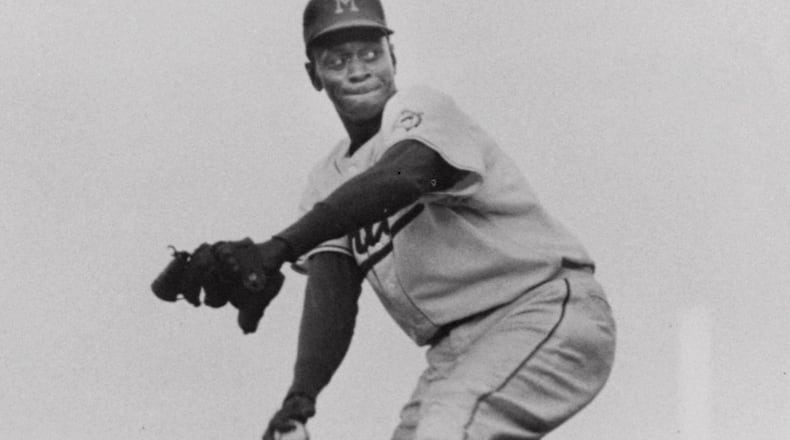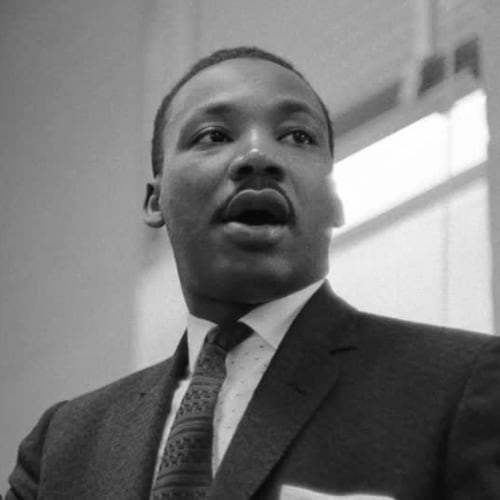Editor’s Note: This story is one in a series of Black History Month stories that explores the role of resistance to oppression in the Black community. A version of this article originally ran on May 12, 2010.
During his 40 years in baseball, fireballer Satchel Paige had a series of patron saints — from J.L. Wilkinson, who signed him to the all-black Kansas City Monarchs when he could barely lift his wounded pitching arm, to Cleveland Indians owner Bill Veeck, who signed Satchel to his first contract in the newly integrated Major Leagues the day he turned 42, to Kansas City A’s boss Charlie Finley, who brought the ancient hurler back for one last go-round at an inconceivable 59.
A new sugar daddy stepped up in 1968. William Bartholomay was a Chicago insurance executive who in 1962 bought the Milwaukee Braves and in 1966 moved them to Atlanta. Bartholomay cared about Satchel enough to hire him as a pitcher-coach-trainer for long enough to meet his pension needs. In case there was any doubt about what he was doing, he assigned Satchel No. 65, the age at which his retirement salary would kick in.
“Baseball would have been guilty of negligence should it not assure this legendary figure a place in the pension plan,” the owner said at the signing in 1968. Looking back 40 years on, Bartholomay says Satchel justified his faith by performing sensationally as a goodwill ambassador.
Credit: George Brace/File
Credit: George Brace/File
He did it partly by signing autographs and spending time with fans. The team was new to Atlanta, and its fans were new to the team and often to baseball itself. Satchel helped with the adjustment. An even richer dividend from hiring him came during the summer of 1968, when riots were raging and cities burning in the wake of Martin Luther King Jr.’s assassination. Having a bridge-builder like Satchel was reassuring to Atlanta and to the Braves. He was not the only Black on the team, just the best-known and most-trusted, a standing that carries special resonance as Major League Baseball readies for its annual Civil Rights Game this weekend in Cincinnati. Satchel had suffered the Jim Crow racial segregation King railed against and embodied the preacher’s dream of an integrated America.
“He came to us four months after the King funeral in Atlanta,” says Bartholomay. “Those were pretty tough times for African-Americans and the country in its entirety. Satchel understood that. He helped in a way that went way beyond baseball.”
Life with Satchel brought new touches to Atlanta’s start-up franchise. A rocking chair was installed in front of his locker. He had young teammates toting his fishing gear and serving as gophers. “He called me Daffy,” says Dusty Baker, now the manager of the Cincinnati Reds. “I said, ‘My name is Dusty.’ He said, ‘Daffy, I know what your name is.’”
On the bus he broke the mournful quiet after painful losses, getting the team laughing with tales of Negro League buddy Cool Papa Bell hitting a popup so high that it took a full day for it to fall back to Earth. On the plane he carried his typewriter, along with a suitcase, clothes bag and attaché case.
Phil Niekro, the world’s most accomplished knuckleballer, recalls Satchel sitting at the back of the plane by himself with his case on the pull-out tray. “I was going to the bathroom and he said, ‘Niekro, sit down for a second. Do you drink?’ I said that I have one now and then and he said, ‘What would you like?’ Anything I wanted was there in his little case.”
What impressed the Torre brothers was Satchel’s attitude about life. “He was always sort of being thankful for just being alive. He was thankful he got the opportunity to play in the majors even as late as he got it,” says Frank. “It was all about life and Satchel enjoyed living,” agrees Joe, manager of the Los Angeles Dodgers: “He never stopped thinking young.”
They called Satchel a trainer, but “he didn’t do any training,” recalls Dave Percley, the Braves’ real trainer. What he wanted to do was pitch. Bartholomay was concerned about his eyesight, “which was going pretty rapidly. We worried that he wouldn’t see a line drive coming back to him.” But Satchel proved that even at the age of 62 the crack of a bat was enough to tell him where the ball was headed, and he pitched a couple of innings in an exhibition game for the Braves’ highest-level minor league team, Triple-A Richmond.
It was a face-off for the ages when fellow Mobilian Hank Aaron stepped to the plate: history's greatest hurler against its greatest hitter. Satchel was smiling as he unleashed his first one, a slow arcing pitch. Hank had stepped out of the box, but too late. Strike one. The next was slower still. Hank dropped his bat into the dirt in disgust. Strike two. The future home run champ checked his swing on the next pitch, making the count one ball, two strikes.
“Now Aaron, still glowering at his old friend, stepped forward in the box as far as rules would allow,” Wilt Browning, who covered the Braves for The Atlanta Journal, remembered years later. “Again Paige’s pitch came floating toward the plate out of the fading light of early evening. Aaron tried to time the pitch. He made a mighty swing. The ball clicked weakly against the top of Aaron’s bat and flew softly, with little arc, to the waiting third baseman for the out. The old man pounded his bony fist into his glove with the sort of youthful joy all of us could understand.”
Larry Tye is a former reporter at the Boston Globe and the author of “Satchel: The Life and Times of an American Legend.”
This year, the AJC’s Black History Month series will focus on the role of resistance to forms of oppression in the Black community. In addition to the traditional stories that we do on African American pioneers, these pieces will run in our Living and A sections every day this month. You can also go to ajc.com/black-history-month for more subscriber exclusives on the African American people, places and organizations that have changed the world.
About the Author
The Latest
Featured


